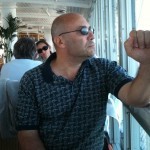Massimo Marino's Blog: The Ramblings and the Rumblings, page 6
February 13, 2016
Brain to Books Cyber Convention
Welcome
Welcome to the 2016 Brain to Books Cyber Convention and to my booth! I am Massimo Marino, a scientist turned author. I’m member of SFWA (Science Fiction and Fantasy Writers of America), and a scientist envisioning science fiction.
I contributed to the experiments at CERN and The Lawrence Berkeley Lab, then accepted leading positions at Apple, Inc., and at the World Economic Forum in its leadership team. I went from smashing particles at the largest accelerators in the world, to smashing words on the most popular laptop in the world.
Click on the picture for the Daimones trailer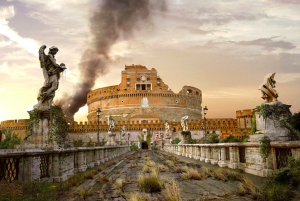
I’m the author of multi-awarded SF trilogy “Daimones” and published by Booktrope LCC.
Daimones is the story of the death and re-birth of the human race, an apocalyptic tale that feels like it could happen tomorrow. You may never sleep through a windstorm again.
Death swept away the lives of billions, but spared Dan Amenta and his family, leading them to an uncertain future. When merely surviving isn’t enough and the hunt for answers begins, memories from the past and troubling encounters lead Dan to the truth about the extermination of the human race. Distressing revelations will give new meaning to their very existence.
Early humans shaped the future and seeded a plan millions of years in the making. Now survivors must choose: Endure a future with no past or fade away into a past with no future?
GIVEAWAY
The Earth in Daimones – An Apocalyptic Travel
And now, let’s have an imaginary travel visiting 28 famous places in the world. Let’s also have a game together to win ebooks, paperbacks, and have fun together, maybe in chatting as well, together, guessing how long it would take for the world to become as in the pictures when we will disappear. To participate and have a chance to win, you need to guess where Daimones is taking you in those 28 stops. Some places are easily recognizable (at least 10), others much less, but all are known iconic places in the cities we’ll explore together through the post-apocalyptic pictures.
The first to guess all 28 places will also win an autographed copy of Daimones
Appearances
I live near the French-Swiss border and will be in my booth from midday (EST) on the 8th, 9th, & 10th of April 2016, but feel free to get in touch with me anytime, always happy to meet readers.

Massimo Marino
Author of the “Daimones Trilogy” – “Nothing prepared us for the last day.”
SF Writers of America Member
2012 PRG Reviewer’s Choice Award Winner in Science Fiction
2013 Hall of Fame – Best in Science Fiction, Quality Reads UK Book Club
2013 PRG Reviewer’s Choice Award Winner in Science Fiction Series
2014 Finalist – Science Fiction – Indie Excellence Awards L.A.
2014 Award Winner – Science Fiction Honorable Mention – Readers’ Favorite Annual Awards
http://Author.to/MassimoMarino
http://massimomarinoauthor.com
http://www.facebook.com/MassimoMarino...
https://plus.google.com/+MassimoMarin...
@Massim0Marin0
The Books in goodreads
The post Brain to Books Cyber Convention appeared first on § A Scientist Envisioning Science Fiction.
January 31, 2016
2016 Brain to Books Cyber Convention
Click on the picture for the Daimones trailer

Welcome to the 2016 Brain to Books Cyber Convention and to my booth! I am Massimo Marino, a scientist turned author. I'm member of SFWA (Science Fiction and Fantasy Writers of America), and a scientist envisioning science fiction.
I contributed to the experiments at CERN, at the Lawrence Berkeley Lab, and at the Stanford Linear Accelerator (SLAC), then accepted leading positions at Apple, Inc., and at the World Economic Forum in its leadership team. I went from smashing particles at the largest accelerators in the world, to smashing words on the most popular laptop in the world.
I'm the author of multi-awarded SF trilogy "Daimones" and published by Booktrope LCC.
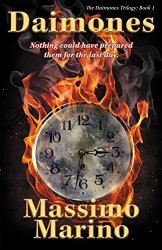
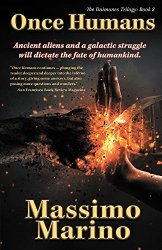
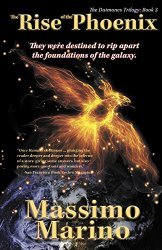
Daimones is the story of the death and re-birth of the human race, an apocalyptic tale that feels like it could happen tomorrow. You may never sleep through a windstorm again.
Death swept away the lives of billions, but spared Dan Amenta and his family, leading them to an uncertain future. When merely surviving isn't enough and the hunt for answers begins, memories from the past and troubling encounters lead Dan to the truth about the extermination of the human race. Distressing revelations will give new meaning to their very existence.
Early humans shaped the future and seeded a plan millions of years in the making. Now survivors must choose: Endure a future with no past or fade away into a past with no future?
GIVEAWAY
The Earth in Daimones - An Apocalyptic Travel
And now, let's have an imaginary travel visiting 28 famous places in the world. Let's also have a game together to win ebooks, paperbacks, and have fun together, maybe in chatting as well, together, guessing how long it would take for the world to become as in the pictures when we will disappear. To participate and have a chance to win, you need to guess where Daimones is taking you in those 28 stops. Some places are easily recognizable (at least 10), others much less, but all are known iconic places in the cities we'll explore together through the post-apocalyptic pictures.
Rules of Participation
The first to guess all 28 places will also win an autographed copy of Daimones
Appearances
I live near the French-Swiss border and will be in my booth from midday (EST) on the 8th, 9th, & 10th of April 2016, but feel free to get in touch with me anytime, always happy to meet readers.

Massimo Marino
Author of the "Daimones Trilogy” - “Nothing prepared us for the last day."
SF Writers of America Member
2012 PRG Reviewer's Choice Award Winner in Science Fiction
2013 Hall of Fame - Best in Science Fiction, Quality Reads UK Book Club
2013 PRG Reviewer's Choice Award Winner in Science Fiction Series
2014 Finalist - Science Fiction - Indie Excellence Awards L.A.
2014 Award Winner - Science Fiction Honorable Mention - Readers' Favorite Annual Awards
http://Author.to/MassimoMarino
http://massimomarinoauthor.com
http://www.facebook.com/MassimoMarino...
https://plus.google.com/+MassimoMarin...
@Massim0Marin0
The Books in goodreads



January 22, 2016
8 Legendary Literary Hotels
This post was posted by the Hipmunk on Hipmunk’s Tailwind blog on the 14th of January.
Stalled on your latest novel? Is the second act of your play not working? What you need is inspiration, and you can find it at these hotels with impressive literary legacies. Maybe the ghosts of famous writers can whisper a few secrets for success.
L’Hotel, Paris
The dying Oscar Wilde once said of his room here, “Either that wallpaper goes, or I do.” Oscar went, and so did the wallpaper, eventually. Now an opulent upscale boutique hotel on the Left Bank, L’Hotel is known for its lush rooms. The Oscar Wilde Suite has his overdue hotel bills framed.
Hotel del Coronado, San Diego
This beach resort features in many movies (like “Some Like It Hot”), but its haunted room prompted Stephen King to write his ultra-creepy story, “1408.” If you want to turn your novel into a screenplay, follow in the footsteps of L. Frank Baum, the writer of “The Wizard of Oz” books, who once stayed there.
The Monteleone, New Orleans
The Monteleone, in New Orleans, features too many stories to describe. Tennessee Williams, Truman Capote, Hemingway and Faulkner all hung out at this hotel, perhaps for the antique rotating Carousel Bar.
The Plaza, New York City
The queen of New York hotels loves writers, especially F. Scott Fitzgerald, who set scenes from “The Great Gatsby” there. Kids love the Eloise Suite, inspired by Kay Thompson’s book about the little girl who lived at the Plaza.
Chateau Marmont, Los Angeles
Besides the rock ‘n’ roll gods, movie stars and rich eccentrics, this LA landmark also provided a writing heaven for Jay McInerney and the incredible Hunter S. Thompson.
Omni Parker House, Boston
This venerable 1854 hotel is still one of Boston’s finest. Back in the day, the Parker House hosted quite the writers’ group: Ralph Waldo Emerson, Henry Wadsworth Longfellow, and Nathanial Hawthorne. Dickens hung out there when he was in town.
The Algonquin, New York City
The Algonquin is the most famous writers’ hotel of all. It garnered it’s still-powerful reputation from the 1920’s Round Table, which comprised the wits of the day, including Dorothy Parker, Robert Benchley, Edna Ferber and others. Writers still love this place.
The Library Hotel, New York City
You know a hotel is serious about writers when the entire place is based on the Dewey Decimal System — Seventh Floor: The Arts, Eighth Floor: Literature, and so on. There’s a Writer’s Den & Poetry Garden and a 6,000-volume book collection, and the hotel is around the corner from the NY Public Library. Check in to Hipmunk deals at The Library Hotel, New York City, and power through that first draft of your novel.
The post 8 Legendary Literary Hotels appeared first on § A Scientist Envisioning Science Fiction.
January 21, 2016
Another Daimones Revelation… Revealed
One more Daimones revelation:
“The loss of Tiamat, and the lives which were also lost, constitute what we call the First Loss. This event took place around 65 million years in the past of your time. Your race caused that loss and all subsequent events.”
Daimones (The Daimones Trilogy Book 1)


Nautilus issue 32: The Day the Mesozoic Died 65 million years ago.
“From the iridium measurements in the clay, the concentration of iridium in so-called chondritic meteorites and the surface area of the Earth, Luis calculated the mass of the asteroid to be about 300 billion metric tons. He then used various methods to infer that the asteroid had a diameter of 10 ± 4 kilometers (km).
Hell on Earth
The asteroid crossed the atmosphere in about one second, heating the air in front of it to several times the temperature of the sun. On impact, the asteroid vaporized, an enormous fireball erupted out into space, and rock particles were launched as far as halfway to the moon. Huge shock waves passed through the bedrock, then curved back up to the surface and shot melted blobs and bedrock out to the edge of the atmosphere and beyond. A second fireball erupted from the pressure on the shocked limestone bedrock. For a radius of a few hundred kilometers or more from ground zero, life was annihilated. Further away, matter ejected into space fell back to earth at high speeds—like trillions of meteors—heated up on re-entry, heating the air and igniting fires. Tsunamis, landslides, and earthquakes further ripped apart landscapes nearer to the impact.
Elsewhere in the world, death came a bit more slowly.
The debris and soot in the atmosphere blocked out the sun, and the darkness may have lasted for months. This shut down photosynthesis and halted food chains at their base. Analysis of plant fossils and pollen grains indicate that half or more plant species disappeared in some locations. Animals at successively higher levels of the food chain succumbed. The K-T boundary marks more than the end of the dinosaurs, it is also the end of belemnites, ammonites, and marine reptiles. Paleontologists estimate that more than half of all the planet’s species went extinct. On land, nothing larger than 25 kilograms in body size survived.
It was the end of the Mesozoic world.”
“Tiamat finally exploded, and the shock disrupted the stability of the solar system. Some from your race left Tiamat in time and survived. Eridu was their destination, a home away from home.”
Massimo Marino is a scientist envisioning science fiction. He spent years at CERN and The Lawrence Berkeley Lab followed by lead positions with Apple, Inc. and the World Economic Forum. He is also co-founder of “Squares on Blue”, a Big Data Analytics service company, and of BookGarage, a publishing service brokerage company.
Massimo currently lives in France and crosses the border with Switzerland multiple times daily, although he is no smuggler. #SFWApro
As a scientist writing science fiction, he went from smashing particles at accelerators at SLAC and CERN to smashing words on a computer screen. He is is now an author with Booktrope Publishing, LCC, and Active Member of SFWA – Science Fiction & Fantasy Writers of America.
smashing particles at accelerators at SLAC and CERN to smashing words on a computer screen. He is is now an author with Booktrope Publishing, LCC, and Active Member of SFWA – Science Fiction & Fantasy Writers of America.
He’s the author of multi-awarded Daimones Trilogy. The 1st volume, Daimones (The Daimones Trilogy Book 1) , published by Booktrope is available since August 2015.
, published by Booktrope is available since August 2015. 
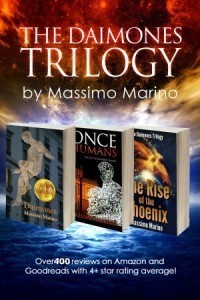 His novels have received the Seal of Excellency from both AwesomeIndies.net and IndiePENdents.org
His novels have received the Seal of Excellency from both AwesomeIndies.net and IndiePENdents.org
• 2012 PRG Reviewer’s Choice Award Winner in Science Fiction
• 2013 Hall of Fame – Best in Science Fiction, Quality Reads UK Book Club
• 2013 PRG Reviewer’s Choice Award Winner in Science Fiction Series
• 2014 Finalist – Science Fiction – Indie Excellence Awards L.A.
• 2014 Award Winner – Science Fiction Honorable Mention – Readers’ Favorite Annual Awards
His novels are available from Amazon, Barnes & Noble (Nook), iTunes Apple Store, and many other retailers around the world.
Join his mailing list for new releases, or follow him on Facebook, Google+, and Twitter.
The post Another Daimones Revelation… Revealed appeared first on § A Scientist Envisioning Science Fiction.
January 20, 2016
SF Predates Science
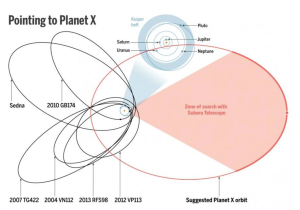 When research is done properly, it often happens that SF predates science. By the way, it’s called URIBI, not Planet X !
When research is done properly, it often happens that SF predates science. By the way, it’s called URIBI, not Planet X !
EVIDENCE FOR A DISTANT GIANT PLANET IN THE SOLAR SYSTEM
Recent analyses have shown that distant orbits within the scattered disk population of the Kuiper Belt exhibit an unexpected clustering in their respective arguments of perihelion requiring a dynamical origin.
The research did find that the observed orbital alignment can be maintained by a distant eccentric planet with mass 10 times that of the planet Earth. The existence of such a planet naturally explains the presence of high-perihelion Sedna-like objects, as well as the known collection of high semimajor axis objects with inclinations between 60° and 150° whose origin was previously unclear.
The Daimones explain and reveal to Dan the existence of a massive 10th planet in our Solar system back in 2012. Of course, they knew of its existence since eons.
Read about cosmology revealed in Daimones from the words of those who have witnessed it.
“Your star is known to your people as Sun. There is still another undiscovered planet beyond Pluto with a large elliptical orbit which your race has yet to discover. We call it Uribi.” Daimones, as revealed in 2012.
Daimones (The Daimones Trilogy Book 1)

http://iopscience.iop.org/article/10.3847/0004-6256/151/2/22/meta
Massimo Marino is a scientist envisioning science fiction. He spent years at CERN and The Lawrence Berkeley Lab followed by lead positions with Apple, Inc. and the World Economic Forum. He is also co-founder of “Squares on Blue”, a Big Data Analytics service company, and of BookGarage, a publishing service brokerage company.
Massimo currently lives in France and crosses the border with Switzerland multiple times daily, although he is no smuggler. #SFWApro
As a scientist writing science fiction, he went from smashing particles at accelerators at SLAC and CERN to smashing words on a computer screen. He is is now an author with Booktrope Publishing, LCC, and Active Member of SFWA – Science Fiction & Fantasy Writers of America.
smashing particles at accelerators at SLAC and CERN to smashing words on a computer screen. He is is now an author with Booktrope Publishing, LCC, and Active Member of SFWA – Science Fiction & Fantasy Writers of America.
He’s the author of multi-awarded Daimones Trilogy. The 1st volume, Daimones (The Daimones Trilogy Book 1) , published by Booktrope is available since August 2015.
, published by Booktrope is available since August 2015. 
 His novels have received the Seal of Excellency from both AwesomeIndies.net and IndiePENdents.org
His novels have received the Seal of Excellency from both AwesomeIndies.net and IndiePENdents.org
• 2012 PRG Reviewer’s Choice Award Winner in Science Fiction
• 2013 Hall of Fame – Best in Science Fiction, Quality Reads UK Book Club
• 2013 PRG Reviewer’s Choice Award Winner in Science Fiction Series
• 2014 Finalist – Science Fiction – Indie Excellence Awards L.A.
• 2014 Award Winner – Science Fiction Honorable Mention – Readers’ Favorite Annual Awards
His novels are available from Amazon, Barnes & Noble (Nook), iTunes Apple Store, and many other retailers around the world.
Join his mailing list for new releases, or follow him on Facebook, Google+, and Twitter.
The post SF Predates Science appeared first on § A Scientist Envisioning Science Fiction.
January 14, 2016
How to Write a Novel
I'm in the process of publishing my 4th novel, an Urban SF YA story. What it dawned on me is that the novel had its reality not as ink on paper, but as a series of experiences in the mind of the reader created by those abstract marks on paper. That's how you engage your readers: The writer conjures a vision, and the way to write the story is by asking yourself how can you give substance to the sensations that vision creates in your mind.
So the book had to be written inside-out. I had to imagine what I wanted to happen inside the reader’s mind, then make the marks on paper that would—to the best of my ability—cause the reader’s internal vision to correspond to my own. If your words don't move you, there's no chance you can move your readers.
January 12, 2016
The Best Hotels for Exploring Literary London
From the shopping at Selfridges to the culture of The British Museum and the history underlining every step through the city, there are countless reasons to visit London. But the bookworm’s most compelling incentive is the rich thread of literary genius woven into the city’s very identity. Virginia Woolf, Charles Dickens, George Eliot, and Geoffrey Chaucer are just a few of the authors whose homes, favorite haunts, or most famous tales are spin on the city’s axis.
You can walk London Bridge and re-live the despair Pip felt when he learned Estella was to be married, or retrace Clarissa Dalloway’s steps to Hatchards Booksellers. To explore all the city’s tales would take lifetimes — that’s why we read books. But if you’re keen to take on a few of your favorite authors or stories in Bloomsbury, Wembley, and Whitechapel, here’s the definitive guide for what to see and where to stay.
1. The Strand Palace
Right in the thick of Central London, The Strand Palace is walking distance from Buckingham Palace and The National Gallery. A stone’s throw from the John Nash-designed Trafalgar Square, note The Fourth Plinth — originally intended to hold a statue of William IV, the plinth is now a platform for temporary, commission-based sculptures. The Square is now the site for many political demonstrations, and a young poet or playwright scribbling in the public square would not be out of place.
From the hotel, it’s just a short bus ride to The British Library. Originally part of the British Museum, the library plays host to over 150 million items. The only larger library in the world is the Library of Congress. The archival collection in the Sir John Ritblat Gallery is a treasure trove containing original copies of Beowulf, Jane Eyre, The Canterbury Tales, and Shakespeare’s first folio. It also houses the Magna Carta and a Gutenberg Bible.
2. St. Ermin’s Hotel, Autograph Collection
A literature lover can’t visit London without spending an hour (or five) at Westminster Abbey, a spot walking distance from St. Ermin’s. While the uninitiated may wonder what a church has to do with literature, to stop shy of doing the research would be a grave mistake (pun intended). See, Westminster Abbey isn’t just a thousand year-old church or the site of every monarch’s crowning since William the Conqueror’s in 1066. It is the burial place of hundreds of famous figures, and plays host to memorials for many more.
In the Abbey’s aptly named Poets’ Corner, Charles Dickens, Robert Browning, Rudyard Kipling, and Alfred, Lord Tennyson all have their final resting places. There are memorial busts and plaques to Jane Austen, Shakespeare, Christopher Marlowe, William Wordsworth, Oscar Wilde, and many more.
Fun fact: Geoffrey Chaucer is buried in the Abbey, but not because of his distinction as an author. Chaucer was, for a time, Clerk of the King’s Works at the Palace of Westminster. When he died in 1400, he was still in favor with the king, and so was buried in the Abbey, with a plain slab to mark his grave. It wasn’t until 1556 that Chaucer’s existing marble monument was erected, and his bones moved to the new location.
3. Grange St. Paul’s
Grange St. Paul’s is a comfortable distance from the Tower of London — a must-see for history and historical-fiction lovers. Famed as a prison for royals throughout history, the Tower has housed Anne Boleyn, Sir Walter Raleigh, and Guy Fawkes, to name a few. A glass pillow marks the spot where Anne Boleyn, Catherine Howard, and Lady Jane Grey were executed on Tower Green. If you time your visit right, you could attend a reading by the queen of Tudor historical fiction herself, Philippa Gregory.
A ten-minute stroll from Grange, Shakespeare’s Globe is a few hundred yards from the original Globe, and has been rebuilt based on the evidence (including sketches, literary references, and similar structures of the time) to provide the closest possible facsimile to the experience theatergoers in Shakespeare’s time would’ve had — down to the reed thatch roof that might leave you soggy on a rainy evening.
Before or after you take in a show at the Globe, stop off at the George Inn — a haunt of both Dickens and Shakespeare, and the only remaining “coaching” inn in London. With all its 16th-century charm, it’s easy to see how the spot earned itself a callout in Little Dorrit.
This sampling of literary London only skims the surface, but this itinerary will show you enough of the city’s charms to keep you hooked for life.
The post The Best Hotels for Exploring Literary London appeared first on § A Scientist Envisioning Science Fiction.
Don’t Show. Period.
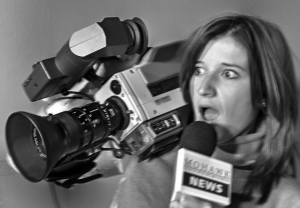 When to show and when to hide
When to show and when to hideA few days ago I ended up caught into a bitter querelle with a reader who happens to be a former journalist. And it showed.
In writing novels, you should never report, but render. You should never get into explanations, but show situations. And you should never show everything at every moment in every paragraph as if it was the magic formulaic panacea to good writing.
“Show, don’t tell” naughty spires
Now, if I had the background of a journalist I would probably get tangled in the same mistake’s naughty spires. As a journalist, when you write an article you need to provide facts, you need to explain, and you need to anchor everything into “some” reality and details with the aim of leaving no space to the reader’s imagination. You don’t want your article to be prone to interpretations, you want one single and one only version, the journalist’s, and there should not be anything left to the readers to fill in with their background, their experience, their inclinations, and their moods. Needless to say, this is orthogonal to how you want to write a novel. You want a novel that becomes a thousand, a million different novel. A different one for every reader.
Of course, it got into a bitter, nasty conversation: two different worlds clashing, two visions that have not much in common but the correct use of the language and its grammar.
Some of the “literary” suggestions coming from the ex-journalist were so twisted that they would make any experienced writer cringe, and confuse those who are only now venturing into writing.
The injunction to explain things in order to anchor the story into reality can be a great idea, but it also get you easily bogged down and make readers yawn. Oftentimes, it turns into a silly, useless dump of informations and becomes a horrendous load of backstory or precise technical schematics, rammed down your poor reader’s throat “otherwise s/he would not get it or believe it.”
Don’t explain
On the contrary, authors get into huge, insane efforts in order to avoid having to come out and explain something. Avoid weird “teachable moments” like the plague, they don’t convey worldbuilding to the reader, their only effect is that the story grinds to a halt.
Whenever “literary” aficionados tackle science fiction or fantasy, they lament the lack of, or suggest to add tons of infodumps. Not being familiar with the genre’s conventions, they fall into beliefs that many “real” SF and fantasy authors avoid at all costs. Sure, sometimes you have to explain something, but that is done as painlessly as you possibly can, and that means the exact opposite of the journalistic’s approach.
If you find it necessary to explain something, find a way to have characters deal with it, but NOT by having them discuss what they know! Never allow characters to tell each other anything that is familiar in their world and everyone “there” knows. It’s tempting to explain things to the reader by using this technique, but it’s a silly mistake. Putting dull lectures into dialogue form does not stop them from being dull lectures.
Don’t explain anything if it is not necessary later on in the story. Don’t show anything you don’t want the reader to pay attention to. “Show, don’t tell” means never to report anything, but it does not mean you have to show everything on every page and at every step. What the writer does not write is as important as the words that find a place in the story.
Cull, cull, cull the unnecessary words
Show only what you want the reader to remember: As Chekhov clearly put it, if you show a gun in one scene, it has to shoot later on in the story. So, check your “showings” and INSTEAD remove everything that has no relevance to the story; better still, don’t show anything that does not have a role in the story.
If the story absolutely will not work without some information, you must embed that knowledge in a scene, and have characters’ actions show the readers what you want them to learn.
With all this said, most background information and explanations can be chopped out of a story with no loss at all. Fear not: the reader generally does not need or want long treatises of background information, or technical details.
Science Fiction is not a technical treatise or scientific article. The writer must know this information because it will make for his vision to be plausible and believable, but in most cases, the story can get along perfectly well without the lecture, and the reader will be much happier without it. Remember Hemingway’s iceberg principle: Only the 7/8 of what the writer knows about his story gets into the pages. The foundations in a construction site are not visible when the building opens its doors (or the novel is published).
Find a way to explain them through action rather than lecturing.
Cum Grano Salis
That is the difference between showing and telling. If a piece of information is important enough to be included in the story, it is probably important enough to warrant at least a brief scene to show it. But, please, select, choose, prioritize, don’t show everything!
Be warned against too much description, the author floats over details that do not advance the story nor provide any new tile to the mosaic. Description for the only reasons to describe is unnecessary, and too much of it patronizes readers’ imagination: they need to fill the gaps created by what is left out so they become part of the story. “Show, don’t tell” is of course a good guidance, but—in SF—don’t show everything, if you want to write good sci-fi that is 
January 6, 2016
Amazon Giveaway
An apocalyptic tale that feels like it could happen tomorrow. You may never sleep through a windstorm again.
See this #AmazonGiveaway for a chance to win: Daimones (The Daimones Trilogy) (Volume 1). https://giveaway.amazon.com/p/6c3d217...
NO PURCHASE NECESSARY. Ends the earlier of Jan 13, 2016 11:59 PM PST, or when all prizes are claimed.
See Official Rules http://amzn.to/GArules.
Giveaway

Duration: Jan 6, 2016 6:03 AM PST - Jan 13, 2016 11:59 PM PST
Prize: Daimones (The Daimones Trilogy) (Volume 1)
Number of Prizes: 2
January 5, 2016
What if...
Would you stay or would you go?



